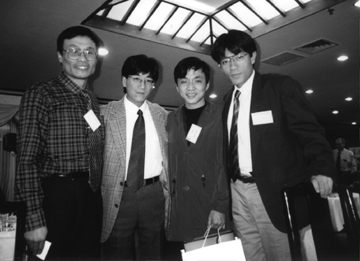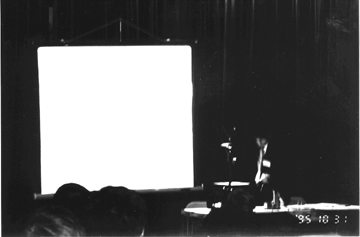
Visitor: Hiroshi Yamakawa (TRC Active Intelligence Laboratory) Period: October 29 - November 4, 1995 (7 days) Place (attended conference): International Conference on Neural Information Processing (ICONIPS '95)
The International Conference on Neural Information Processing (ICONIPS) is a highly reputed international conference held in Asia on neuro-computing technologies under the sponsorship of IEEE and other organizations. This year, Beijing played host to the conference. I participated in ICONIPS '95 with Dr. Sato of TRC to make a presentation on my own research and find out about the status of research activities related to RWC research in other countries.

When we disembarked at the Beijing International Airport, which looked like an isolated island in the yellowish desert as we approached it, we found that the atmosphere was very dry. During this time of year, Beijing has cold, dry weather and tourists often get sore throats.
In the late afternoon of the day of our arrival, we went downtown from our hotel by taxi. The driver drove much farther than necessary and charged us more than the meter reading. We didn't know numbers in Chinese and could not negotiate with him for the fee. From this experience, we decided to use buses and always bring a pen and paper.
While we were strolling about through the crowded alleys filled with mixture of exotic scents, we could hear many calls and phrases in the unfamiliar language of Chinese. After walking for a while in the crowd, we found there were certain patterns of sound. I hit on the idea that"The segmentation of speech recognition maybe starts like this." This idea might probably come because I did not study Chinese at all before the trip. However, I decided that we should have learned even a few Chinese words when we sat at a table, struggled to make order and were forced to wait with empty stomachs in the restaurant that we finally reached after a long walk.
In the plenary session of the conference, Prof. Amari briefly summarized the "Century of the Brain" project and other neuro-computing technology research in Japan. Following Prof. Amari's presentation, a representative from the China Neural Network Council introduced the current status of neuro-computing research in China, pointing out the fact that his country is currently focusing on this area.
Prof. Lei Xu from Hong Kong University described their newly developed "Yin-Yang (negative/positive)" machine. In the main sessions, 145 oral presentations and 95 poster presentations were made on many themes including Neurodynamics, Fractals and Chaos, Bio-Information Processing, Intelligence, Optimization, Applications, Implementation, Image Processing, Neuron Models and Network Architecture, Speech, Hearing and Pattern Recognition and Learning Algorithms.
Most Japanese presentations were made by researchers from universities: five from the University of Electro-Communications, two from Meiji University and the University of the Ryukyu respectively and one each from Tokyo Metropolitan University, Yamagata University, Tokai University and Miyazaki University respectively. In addition, the Electrotechnical Laboratory and FED individually present a paper and two other papers from MECCS Japan Co., Ltd. were delivered.
I made my presentation,"A Method for Automatically Acquiring Inner Representations by using a Hierarchical Autoencoder Neural Network Model," in the Intelligence session. I believe this method will have a key role in the development of flexible intelligent systems. Dr. Sato, the other presenter from TRC, took part in the Implementation session for his presentation entitled "Development of a High-Performance Simulator for Cooperative Clustered Recurrent Neural Networks."
As pointed out in the panel discussion for "gintelligence," the overall atmosphere of the conference focused on the importance of integration of a variety of technologies. In other words, as fundamental element technologies such as neuro-computing, GA, fuzzy theory and artificial life established, researchers in individual areas have learned the limitation of each technology and have found it necessary to supplement the drawbacks of these technologies. I myself have come to believe that global research strategies will be increasingly required for information processing research in RWCP.
Beijing is now dramatically transforming itself into a modern city and more research and academic institutes have started using the Internet. However, Chinese researchers still face a number of difficulties in making technical visits to other countries including Japan.
On the morning of our day of departure, I went to a lake-side garden called "Iwa-en" in the north-western part of the city. I heard and saw local people practicing tai chi chuan and other exercises. It gave me the impression that the Chinese are more energetic than the Japanese.
